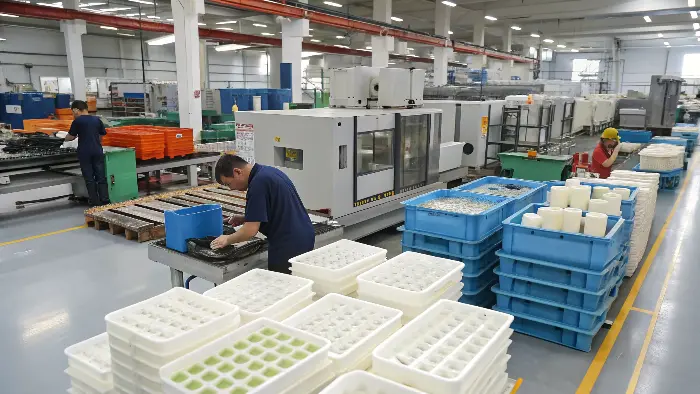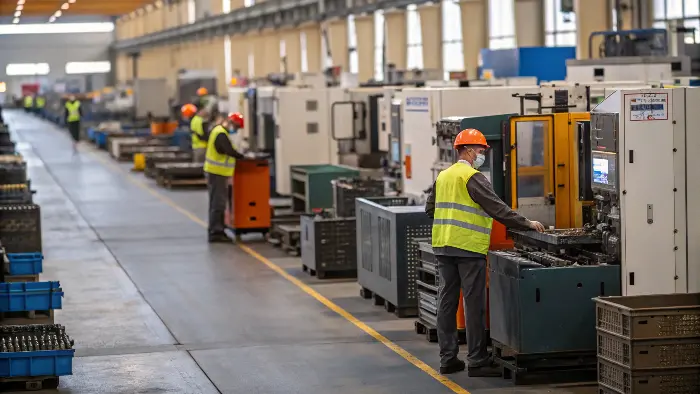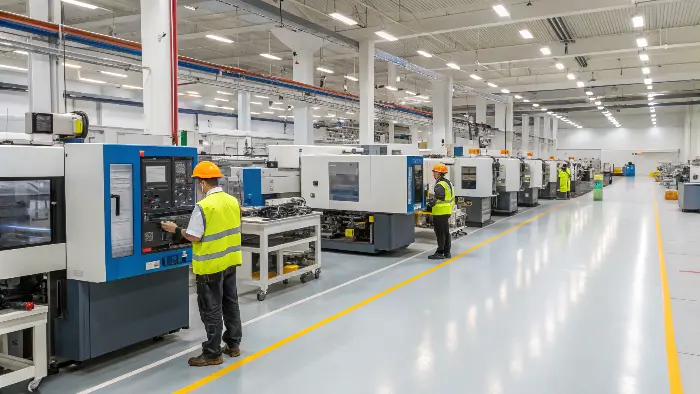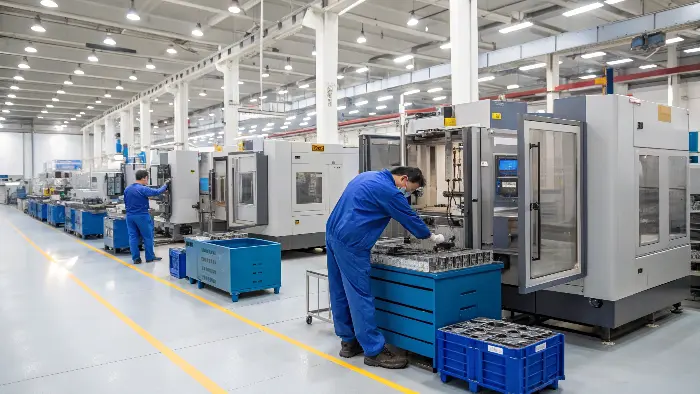Sourcing custom plastic parts from China is a not easy step especially for new customers you might be overwhelmed by the choices and unsure where to even start. The good news is that China’s manufacturing landscape is vast, and I’m here to help you navigate it.
You can find custom injection molded parts in China as it has a large and mature manufacturing industry of injection molded parts. Factories are located throughout the country, especially in the eastern and south-central regions. Many companies offer custom injection molding services, from simple parts to complex designs. They can handle both prototyping and mass production.

So, the answer is a resounding yes, but "anywhere" needs a bit of qualification. While factories are widespread, certain regions specialize and offer more choices. Understanding this landscape is the first step. Let’s explore what this means for you and your project. I believe that knowing where to look and what to expect can make all the difference.
How much does injection molding cost in China?
China is renowned for competitive manufacturing, but the cost could be different.The injection molding cost in China could be significantly different depending on a host of variables like:
- The intricacy of the mold
- Material choice
- Part size
- Quantity
- The manufacturer’s capabilities.
If you wish to determine whether Chinese injection molding is affordable to you, you must find out the cost incurred.
**The cost of injection molding in China is generally lower than in most Western countries depending on factors like labor costs and economies of scale. The final cost, however, depends on part complexity, material choice, quantity produced, and mold costs. Simple parts in large quantities can be extremely inexpensive, while complex parts using specialty resins will be pricey.

Let’s dive deeper into what makes the cost of injection molding less costly in China. There are lots of reasons for this reason.
Part design is a major driver. More complex parts with intricate features, tight tolerances will require more complex molds so it will cost you more as comapred a simple mold with less features.
Second, the plastic material you choose significantly impacts the cost. Common commodity resins like Polypropylene (PP) or Polyethylene (PE) are relatively cheap. Engineering resins like Polycarbonate (PC), ABS, or Nylon will be more expensive. High-performance or specialized resins can increase material costs substantially.
Third, production volume plays a huge role. Higher volumes mean the initial mold cost is spread over more parts, reducing the per-part cost. Large orders also allow for more efficient production runs.
Fourth, the mold cost itself is a big upfront investment. We’ll talk more about this separately, but it’s a key component of the overall project cost.
Finally, labor costs in China are generally lower than in many Western countries, which contributes to the overall cost-effectiveness. However, this is changing, and skilled labor costs are rising.
I remember a client who wanted a very complex part made from a high-temperature, medical-grade PEEK material. The part volume was initially quite low. The per-part price quote from China was higher than they expected. We broke it down: the material was expensive, the mold needed special steel and intricate cooling due to the high processing temperature, and the low volume meant the mold cost amortization was high. Once they understood these factors, the price made sense. We then worked on optimizing the design slightly to reduce mold complexity, which helped a bit.
Here’s a table summarizing the main cost drivers:
| Cost Factor | Influence on Price |
|---|---|
| Part Complexity | Higher complexity increases mold and potentially cycle time. |
| Material Type | Commodity resins are cheaper; engineering resins cost more. |
| Production Volume | Higher volume generally means lower per-part cost. |
| Mold Cost | Significant upfront cost, amortized over parts. |
| Labor Costs | Generally lower in China but varies by region/skill. |
| Surface Finish | High polish or special textures add to mold cost. |
| Tolerances | Tighter tolerances require more precise molds and processes. |
Understanding these elements will help you get more accurate quotes and manage your budget effectively.
–
The number of cavities in the mold directly impacts its cost and the production rate. A single-cavity mold produces one part per cycle. A multi-cavity mold (e.g., 2, 4, 8, 16, or more cavities) produces multiple parts per cycle, reducing the per-part molding cost but significantly increasing the mold’s price and complexity.
The required lifespan of the mold also influences material choice and design. A mold expected to produce millions of parts needs to be built to a higher standard than one for only a few thousand.
Other factors include the type of runner system (cold runner vs. hot runner, with hot runners being more expensive but often more efficient for large volumes) and any special surface finishes or textures required.
I once worked with a startup that had a brilliant product idea but a very limited budget. They needed a mold for their first production run. We discussed their volume expectations. Initially, they wanted a 4-cavity mold to get parts faster. However, after analyzing their budget and initial sales forecast, we decided a 2-cavity mold made with good quality P20 steel was a more realistic starting point. It lowered the upfront mold cost significantly, allowing them to launch. Later, as sales grew, they invested in a higher-cavitation, hardened steel mold. It’s about matching the mold investment to the business reality.
Here’s a breakdown of mold cost factors:
| Mold Cost Factor | Influence on Price |
|---|---|
| Part Size | Larger parts generally require larger, more expensive molds. |
| Part Complexity | Intricate features, undercuts, threads increase cost. |
| Mold Steel Type | Hardened steels (H13, S136) cost more than P20. |
| Number of Cavities | More cavities mean higher mold cost but lower part cost. |
| Mold Lifespan | Longer lifespan requirements mean better materials/design. |
| Runner System | Hot runner systems are more expensive than cold runners. |
| Surface Finish | High polish, texturing, or special coatings add cost. |
Getting detailed quotes from several mold makers and discussing these factors is crucial.
Which country is best for injection molding?
Looking for the absolute "best" place globally for injection molding? This is a common question, but the answer isn’t simple. If you’re weighing options beyond China, or just want to understand China’s position, it’s helpful to look at the bigger picture.
There isn’t one single "best" country for injection molding that fits every project. China is a strong contender, especially for cost-effectiveness and high-volume production. However, countries like Germany, Japan, and the USA excel in high-precision, advanced technology, and specialized applications. The "best" choice depends on your specific priorities: cost, quality, speed, complexity, and intellectual property concerns.

Let’s dive deeper into what makes a country a good choice for injection molding. It’s really about finding the best fit for your specific needs.
China stands out for its massive manufacturing capacity, well-developed supply chains, and generally lower costs, especially for labor and tooling. China, with 31% market share, is the world’s largest producer of plastics. Plastic raw material is plentiful in the country. China is also the world’s largest injection molding machine producer. So, you will see factories wherever you go in China, but the most dense in the East and Central South. It is not that difficult to locate a Chinese factory that has experience and expertise in the process. The majority of factories are technologically advanced with production systems, i.e., they can produce large orders competitively. If that is not yet sufficient, the world-class infrastructure system in China ensures the delivery of the products to the remotest corners of the world.
This makes it very attractive for a wide range of products, particularly consumer goods and high-volume parts where cost is a major driver. The skill level has also increased significantly over the years.
Germany and Japan are renowned for their engineering excellence, precision manufacturing, and leadership in advanced molding technologies and automation. If your project demands extremely tight tolerances, complex mechanisms, or cutting-edge materials, these countries often lead. However, costs are typically much higher.
The USA has a strong injection molding industry, particularly for medical devices, automotive components, and projects where proximity, quick turnaround, or IP protection are paramount. While costs can be higher than in China, "reshoring" and local manufacturing offer benefits for some companies.
Other countries like Mexico, Vietnam, India, and Eastern European nations are also growing their injection molding capabilities, often offering a balance of cost and quality, or specializing in certain niches.
I’ve worked with clients who sourced molds from Germany for highly critical medical components where precision was non-negotiable, and the budget allowed for it. I’ve also helped many clients achieve excellent results with Chinese manufacturers for a vast array of products, from electronics enclosures to household items. The key is to match the project requirements with the strengths of the manufacturing location. For many projects I encounter through CKMOLD, China offers an unbeatable combination of capability and value. It’s about understanding the trade-offs.
Here’s a simplified comparison:
| Country/Region | Strengths | Considerations |
|---|---|---|
| China | Cost-effectiveness, high volume, vast capacity | IP protection, quality variability (vetting needed) |
| Germany | Precision, high technology, quality | High cost, longer lead times sometimes |
| Japan | Precision, automation, quality | High cost, communication can be a factor |
| USA | IP protection, proximity (for US market), quality | Higher labor costs |
| Other Asia | Emerging cost advantages, specific niches | Infrastructure, consistency can vary |
Your "best" choice depends on a careful evaluation of your project’s specific needs against these factors.
Applications of Injection Molding
Injection molding is the big deal for producing a whole lot of plastic parts—car components, medical equipment, you name it. It’s very cost-effective because it can make a lot of the same plastic components with close tolerances at low cost per part. That is why most industries use it in mass production. It has high quality and quick production regardless of whether the product is simple or complicated.
- Gears: Robust, high-tolerance gears for machinery and electronics.
- Housings: Durable housings for electronics, automotive parts, and industrial equipment.
- Enclosures: Accurate enclosures for electronic components, safeguarding internal components.
- Handles: Long-lasting, comfortable handles for products, appliances, and tools.
- Caps and Closures: Well-functioning caps and closures for bottles, which have good sealing.
- Connectors: Small, delicate connectors for electrical and electronic purposes.
Who is the best mold maker in China?
Searching for the best mold maker in China or any other country is not an easy step. If you want to find a top-tier mold maker partner for your project, you need to be master in some identification and assessment.
Identifying the single "best" mold maker in China is difficult because "best" depends on your specific needs (e.g., mold complexity, industry, volume, budget). Many highly capable mold makers exist. The key is to find a reputable, experienced maker with good communication, a proven track record relevant to your project, and a commitment to quality. Due diligence is crucial.

Let’s explore how to find a good or even excellent mold maker in China, rather than chasing a mythical "best." The Chinese mold-making industry is vast and diverse.
First, define your requirements clearly. What kind of mold do you need? What industry is it for (e.g., automotive, medical, consumer electronics)? What are your quality standards, expected volume, and budget? A maker specializing in simple, high-volume consumer goods might not be the best choice for a complex, low-volume medical device mold.
Look for experience relevant to your project. Ask for case studies or examples of similar molds they have built. A company with a long history of making molds for your specific type of product or industry is a good sign.
Check their quality control systems. Do they have ISO certification? What kind of inspection equipment do they use (CMM, projectors)? How do they ensure mold trial success and part quality?
Communication is key. Ensure they have English-speaking staff who can understand your technical requirements and provide regular updates. Miscommunication can lead to costly errors.
Consider their engineering capabilities. Do they offer Design for Manufacturability (DFM) analysis? Can they help optimize your part design for better molding?
Don’t just rely on online directories. Seek referrals, visit trade shows (if possible), or work with a trusted sourcing partner or consultant who knows the landscape. I’ve spent years building relationships and understanding the capabilities of different suppliers. It’s this groundwork that helps me connect clients with reliable mold makers.
I always tell my clients, finding a good mold maker is like finding a good doctor. You want someone skilled, experienced in your specific "ailment" (project type), and with whom you can communicate effectively. It’s not about finding the one with the flashiest website, but the one who can deliver the results you need.
Here are criteria for selecting a good mold maker:
| Criteria | Importance |
|---|---|
| Relevant Experience | Proven track record with similar molds/industries. |
| Quality Systems | ISO certification, robust QC processes, good inspection equipment. |
| Engineering Capability | DFM analysis, design support, problem-solving skills. |
| Communication | Clear, responsive, English-speaking contacts. |
| Equipment & Facility | Modern machinery, well-maintained workshop. |
| References/Reputation | Positive feedback from previous clients. |
| Price & Lead Time | Competitive, but not the sole factor; realistic delivery schedules. |
| After-Sales Support | Willingness to support mold adjustments or repairs if needed. |
Thorough vetting is essential to find a mold maker that will be a true partner for your project.
Conclusion
Sourcing injection molded parts directly in China, and it’s usually a very cost-effective solution. Knowing what the cost involved is, how molds are charged for, and comparing it with other countries of manufacture will enable you to make an intelligent decision. To get maximum value, it’s necessary to work with knowledgeable manufacturers, make a good mold design investment, and focus on quality control throughout. Doing this allows businesses to get best value pricing without sacrificing product quality.
I wish this piece of writing by CKMOLD could assist you with your process of production.
